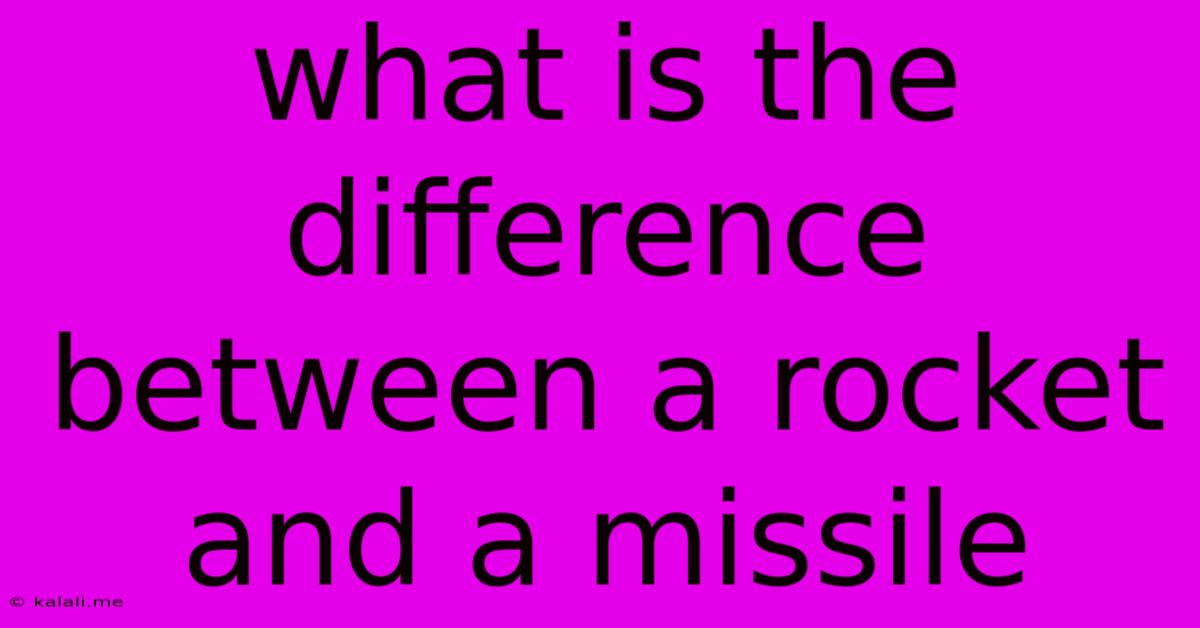What Is The Difference Between A Rocket And A Missile
Kalali
Jun 06, 2025 · 2 min read

Table of Contents
What's the Difference Between a Rocket and a Missile? A Clear Explanation
Understanding the difference between rockets and missiles can be tricky, as they share some key similarities. Both use rocket propulsion to travel through the air, but their primary purposes and design features set them apart. This article will delve into those crucial distinctions, clarifying the core differences between these powerful technologies.
Rockets: Essentially, a rocket is a vehicle propelled by a rocket engine. Its purpose is primarily to carry a payload – this could be anything from satellites and astronauts into space to scientific instruments high into the atmosphere. While some rockets are guided, their primary function isn't to hit a specific target with pinpoint accuracy.
Key Characteristics of Rockets:
- Primary Purpose: Transportation and exploration. They carry payloads to different destinations, often focusing on altitude and distance rather than precision targeting.
- Guidance System: May or may not have a sophisticated guidance system. Some are simply launched and follow a pre-determined trajectory, while others have advanced systems for precise positioning.
- Target: Not inherently designed to hit a specific target. The destination is often a location in space or a high-altitude point.
- Examples: The Saturn V rocket (Apollo missions), SpaceX Falcon 9, and various sounding rockets used for atmospheric research.
Missiles: A missile is, in essence, a guided rocket. The crucial difference lies in its primary function: to deliver a payload, typically a warhead, to a specific target with considerable accuracy. This means missiles have sophisticated guidance and control systems designed for precision strikes.
Key Characteristics of Missiles:
- Primary Purpose: To deliver a destructive payload (warhead) to a specific target. Accuracy is paramount.
- Guidance System: Always equipped with advanced guidance systems, often utilizing GPS, inertial navigation, or radar for precise target acquisition and tracking. These systems enable them to maneuver and correct their trajectory mid-flight.
- Target: Designed to hit a specific, pre-determined target with a high degree of accuracy.
- Examples: Cruise missiles, ballistic missiles (like ICBMs and SRBMs), and anti-aircraft missiles.
Overlapping Features and Considerations:
It's important to note that there's some overlap. Both rockets and missiles rely on rocket propulsion. Some rockets can be adapted for military applications, blurring the lines. However, the core distinction remains the primary purpose. A rocket aims to transport a payload; a missile aims to destroy a target.
Furthermore, the term "rocket" is often used generically, even when referring to missiles. However, understanding the nuanced differences provides a more precise and comprehensive understanding of these powerful technologies. Considering the guidance system and intended use is key to differentiating between a rocket and a missile.
In Summary: While both rockets and missiles employ rocket propulsion, their objectives fundamentally differ. Rockets focus on transportation, while missiles prioritize precision targeting and the delivery of a destructive payload. This distinction highlights the critical differences in their design, functionality, and application.
Latest Posts
Latest Posts
-
How Much Weight Can Plywood Hold
Jun 06, 2025
-
Search Bar With Button In It
Jun 06, 2025
-
Where Are Custom Theme Of Ppt Saved On Mac
Jun 06, 2025
-
Connect My Laptop Keyboard To Androind Phone
Jun 06, 2025
-
Why Are Americans So Good At Everything
Jun 06, 2025
Related Post
Thank you for visiting our website which covers about What Is The Difference Between A Rocket And A Missile . We hope the information provided has been useful to you. Feel free to contact us if you have any questions or need further assistance. See you next time and don't miss to bookmark.